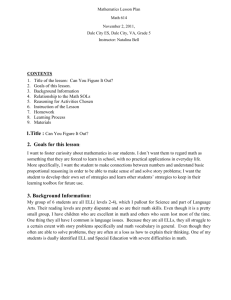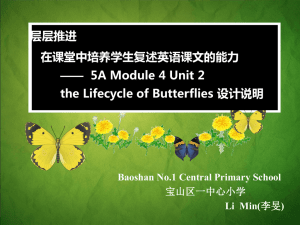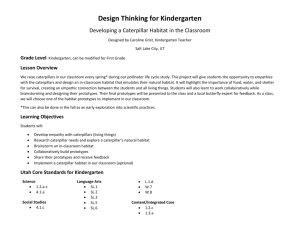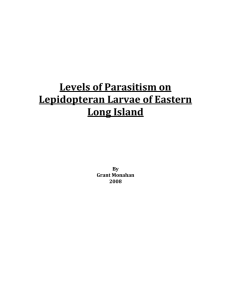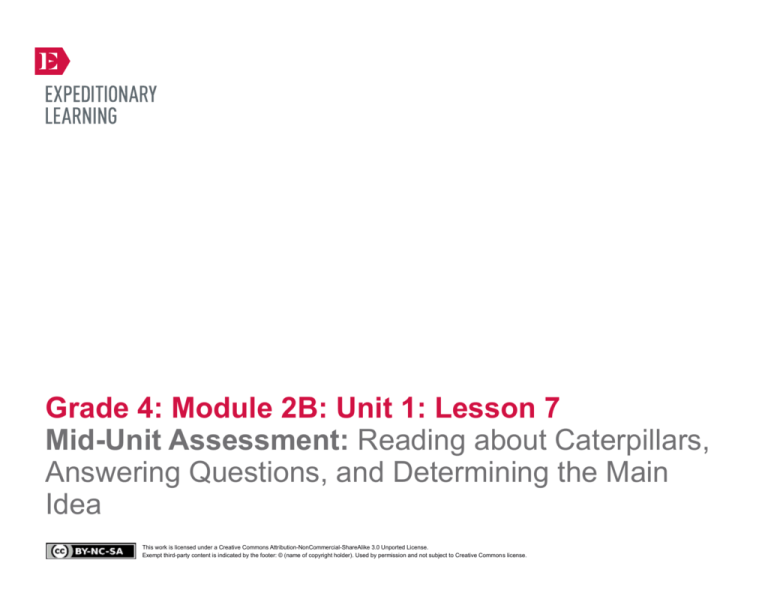
Grade 4: Module 2B: Unit 1: Lesson 7
Mid-Unit Assessment: Reading about Caterpillars,
Answering Questions, and Determining the Main
Idea
This work is licensed under a Creative Commons Attribution-NonCommercial-ShareAlike 3.0 Unported License.
Exempt third-party content is indicated by the footer: © (name of copyright holder). Used by permission and not subject to Creative Commons license.
GRADE 4: MODULE 2B: UNIT 1: LESSON 7
Mid-Unit Assessment:
Reading about Caterpillars, Answering Questions,
and Determining the Main Idea
Long-Term Targets Addressed (Based on NYSP12 ELA CCLS)
I can determine the main idea using specific details from the text. (RI.4.2)
I can interpret information presented through charts or graphs. I can explain how that information helps me understand the text around it. (RI.4.7)
I can determine the meaning of academic words or phrases in an informational text. (RI.4.4)
I can determine the meaning of content words or phrases in an informational text. (RI.4.4)
Supporting Learning Targets
Ongoing Assessment
• I can make inferences about caterpillar defense mechanisms by examining articles that include text and
diagrams.
• Mid-Unit 1 Assessment
• Animal Defenses research journal glossary
• I can determine the main idea of a text on caterpillar defense mechanisms.
• I can find the meanings of unfamiliar words to help me better understand “Award-Winning Survival
Skills: How Animals Elude Prey.”
Copyright © 2013 by Expeditionary Learning, New York, NY. All Rights Reserved.
NYS Common Core ELA Curriculum • G4:M2B:U1:L7 • June 2014 •
1
GRADE 4: MODULE 2B: UNIT 1: LESSON 7
Mid-Unit Assessment:
Reading about Caterpillars, Answering Questions,
and Determining the Main Idea
Agenda
Teaching Notes
Opening
• This is the third lesson where students reread sections from Animal Behavior: Animal Defenses. In the
previous lessons, students worked in expert Jigsaw groups to examine a diagram in their section of the
anchor text, determine the main idea of their section, and identify details that support the main idea. In
this lesson, students make meaning of unfamiliar words in their section of the text.
A. Reviewing Learning Targets (5 minutes)
Work Time
A. Mid-Unit 1 Assessment: Answering Questions and
Determining the Main Idea of a Text about
Caterpillars (30 minutes)
B. Rereading an Informational Text: A Closer Look at
Words (15 minutes)
Closing and Assessment
A. Reflect on Learning Targets: Tracking My Progress
(10 minutes)
• Students work in partners while figuring out the meaning of unknown words. You may wish to
determine the partnerships in advance and strategically group students. One possible arrangement you
may consider would be to partner ELLs who speak the same home language in the same group, allowing
them to have more meaningful discussions and clarify points in their native language. Or, you may
partner students who have demonstrated proficiency with this target with students who have been
struggling so the proficient students may support the students who struggle.
• In advance: Determine partnerships.
• Post: Learning targets.
Homework
A. Continue your independent reading.
Copyright © 2013 by Expeditionary Learning, New York, NY. All Rights Reserved.
NYS Common Core ELA Curriculum • G4:M2B:U1:L7 • June 2014 •
2
GRADE 4: MODULE 2B: UNIT 1: LESSON 7
Mid-Unit Assessment:
Reading about Caterpillars, Answering Questions,
and Determining the Main Idea
Lesson Vocabulary
Materials
progress, track, reflect
• Mid-Unit 1 Assessment: Reading about Caterpillars, Answering Questions, and Determining the Main Idea (one per student)
• Mid-Unit 1 Assessment: Reading about Caterpillars, Answering Questions, and Determining the Main Idea (answers, for
teacher reference)
• Animal Behavior: Animal Defenses (one per student)
– Teacher model—“Avoiding Danger” (page 7–9, stopping at “Self-Defense”; last two paragraphs on page 21; “Escape
Artists” first two paragraphs on page 22)
– Group 1—“Bad Smells, Bad Tastes, and Powerful Poisons” (page 55–top of 56, stopping at “Poisonous Prey”; pages 58–
60)
– Group 2—“Venomous Stings and Bites” (page 73; “How Venom Works” box on page 76; “Stinging Tentacles” pages 77–78)
– Group 3—“Mimicry” (pages 91–94)
• Close Readers Do These Things anchor chart (from Module 1, Unit 1, Lesson 3; or re-created in this module, Lesson 2)
• Vocabulary Strategies anchor chart (from Lesson 3)
• Equity sticks
• Animal Defenses research journal (from Lesson 1; one per student)
• Animal Defense Mechanisms glossary (page 26 of Animal Defenses research journal; from Lesson 3; one per student and
one to display)
• Sticky notes (two per student)
• Animal Defense Mechanisms Word Wall (from Lesson 3)
• Blank Word Wall cards (one index card for every two students)
• Tracking My Progress, Mid-Unit 1 recording form (one per student and one to display)
Copyright © 2013 by Expeditionary Learning, New York, NY. All Rights Reserved.
NYS Common Core ELA Curriculum • G4:M2B:U1:L7 • June 2014 •
3
GRADE 4: MODULE 2B: UNIT 1: LESSON 7
Mid-Unit Assessment:
Reading about Caterpillars, Answering Questions,
and Determining the Main Idea
Opening
Meeting Students’ Needs
A. Reviewing Learning Targets (5 minutes)
• Tell students that today they will complete a formal assessment in which they will do on their own much of what they have
been practicing:
• Discussing and clarifying the
language of learning targets helps
build academic vocabulary.
– Examine and make inferences about a diagram in an informational text.
– Read an informational text.
– Identify and record the main idea in the graphic organizer.
– Answer questions that are dependent on the text.
• Remind them that they will need to refer to the text in order to answer the questions thoroughly.
• Encourage the students to do their best. Let them know that this is a chance to show what they know and how much effort
they are making to read carefully and identify important details in an informational text. This also is an opportunity to
discover even more about animal defense mechanisms.
• Ask the students to read the first two learning targets silently:
* “I can make inferences about caterpillar defense mechanisms by examining articles that include text and diagrams.”
* “I can determine the main idea of a text on caterpillar defense mechanisms.”
• Have them give a thumbs-up if they are clear on what they will be expected to do, a thumbs-sideways if they understand part
but not all of what to do, and a thumbs-down if they are very unsure about what they should do. Address any clarifying
questions before beginning the assessment.
Copyright © 2013 by Expeditionary Learning, New York, NY. All Rights Reserved.
NYS Common Core ELA Curriculum • G4:M2B:U1:L7 • June 2014 •
4
GRADE 4: MODULE 2B: UNIT 1: LESSON 7
Mid-Unit Assessment:
Reading about Caterpillars, Answering Questions,
and Determining the Main Idea
Work Time
Meeting Students’ Needs
A. Mid-Unit 1 Assessment: Answering Questions and Determining the Main Idea of a Text about Caterpillars
(30 minutes)
• Distribute the Mid-Unit 1 Assessment: Reading about Caterpillars, Answering Questions, and Determining
the Main Idea to each student. Address any clarifying questions.
• If students receive accommodations
for assessments, communicate with
the cooperating service providers
regarding the practices of
instruction in use during this study
as well as the goals of the
assessment.
• Give students 30 minutes to complete the assessment.
• While students are taking the assessment, circulate to monitor their test-taking skills. This is an opportunity to analyze
students’ behaviors while taking an assessment. Document strategies students are using during the assessment. For
example, look for students annotating their text, using their graphic organizer to take notes before answering questions, and
referring to the text as they answer questions.
• For some students, this assessment
may require more than the 30
minutes allotted. Consider
providing students time over
multiple days if necessary.
• Asking students to identify
challenging vocabulary helps them
monitor their understanding of a
complex text. When students
annotate the text by circling these
words, it can also provide a
formative assessment for the
teacher.
B. Rereading an Informational Text: A Closer Look at Words (15 minutes)
• Explain to students that they will now have a chance to reread their section from Animal Behavior: Animal Defenses
again and practice figuring out the meaning of challenging words. Remind and point out on the Close Readers Do These
Things anchor chart that close readers read and reread texts many times in order to deeply understand a text.
• Review the Vocabulary Strategies anchor chart and use equity sticks to call on students to read the strategies listed
in the previous lesson. Invite students to turn and talk, asking:
* “What strategy do you use most often trying to figure out what a word means?”
Copyright © 2013 by Expeditionary Learning, New York, NY. All Rights Reserved.
NYS Common Core ELA Curriculum • G4:M2B:U1:L7 • June 2014 •
5
GRADE 4: MODULE 2B: UNIT 1: LESSON 7
Mid-Unit Assessment:
Reading about Caterpillars, Answering Questions,
and Determining the Main Idea
Meeting Students’ Needs
Work Time (continued)
• Cold call two or three students to share their partner’s response.
• Tell students that they now are going to practice some of these strategies while rereading Animal Behavior: Animal
Defenses to determine the meaning of some challenging words.
• Invite students to take out their homework from Lesson 6—a list of words that you do not know the meaning of, the
definition of one word from that list, and an explanation for how you figured out what the word meant. Explain to students
that they will choose at least three of these words to define and record in their Animal Defenses research journals.
• Invite students to open to the Animal Defense Mechanisms glossary on page 26 in the back of their research journals.
Remind students that glossaries are a text feature authors often use in nonfiction texts, and that they are found at the end of
books. Also remind students that they are formatted so the words appear in alphabetical order. Ask:
* “What do we do when recording a word into the glossary of our research journals?”
• Listen for responses like: “We will find the word we are defining in the glossary, then write the definition, then write the
vocabulary strategy we used to determine the meaning of that word, and then draw a quick sketch or diagram showing what
that word means.”
• Explain that with a partner from their expert Jigsaw group, students will reread the text after they have determined and
recorded the definitions of these words and talk with their partners about their understanding of the words. Post the
following directions:
1. Find the meaning of at least three words you recorded for homework after Lesson 6.
2. With your partners, determine the meaning of each word.
3. Find the word in your glossary and write the definition, the strategy you used to figure out the meaning, and a sketch
representing the word.
4. Reread the text with your partners.
5. Discuss the following questions: How has your understanding of these words changed? Which words are still confusing
for you and why? Record your questions on a sticky note.
Copyright © 2013 by Expeditionary Learning, New York, NY. All Rights Reserved.
NYS Common Core ELA Curriculum • G4:M2B:U1:L7 • June 2014 •
6
GRADE 4: MODULE 2B: UNIT 1: LESSON 7
Mid-Unit Assessment:
Reading about Caterpillars, Answering Questions,
and Determining the Main Idea
Meeting Students’ Needs
Work Time (continued)
• If necessary, review Steps 1 and 2 briefly by saying: “Let’s review how we did this with the word ‘predator.’ First we flipped
through the glossary until we found it. Remember, it’s set up so the words are in alphabetical order, so since that starts with
the letter P, it was toward the middle of the glossary. Then we wrote the definition of the word. We figured out that it meant
an animal that lives by killing and eating another animal, so that’s what we wrote in the definition box. Then we thought
about what vocabulary strategy we used to figure out the meaning of that word. We read on in the article and did some
inferring to figure out what it meant. So I wrote ‘reading on in the text and infer’ in the ‘Vocabulary Strategy I Used to Learn
This Word’ box. The last thing we did was a quick sketch showing what this word meant. I drew a sketch of an armadillo and
a jaguar since that was an example from the article, and I drew an arrow pointing to the jaguar since that’s the predator in
the sketch.”
• Give students 10 minutes to look at least three words from their lists, record their definitions, strategy used, and sketch, and
discuss their understanding. Circulate and support pairs as needed. Remind them to record their words at the end of their
glossaries. If necessary, ask questions like: “How did you figure out the meaning of that word?” or “Are there any clues in the
article that can help you figure out what that word means?” Listen for students discussing the meanings of the words and
using strategies from the Vocabulary Strategies anchor chart when determining the meanings.
• Cold call partners to share their definitions and visuals/notes for each word. Clarify the definition of each word if necessary.
• Point out the Animal Defense Mechanisms Word Wall to students. Distribute one blank Word Wall card (index
card) to each pair. Invite student pairs to choose a word they discussed to write on their Word Wall card and post to the
Word Wall.
Copyright © 2013 by Expeditionary Learning, New York, NY. All Rights Reserved.
NYS Common Core ELA Curriculum • G4:M2B:U1:L7 • June 2014 •
7
GRADE 4: MODULE 2B: UNIT 1: LESSON 7
Mid-Unit Assessment:
Reading about Caterpillars, Answering Questions,
and Determining the Main Idea
Closing and Assessment
Meeting Students’ Needs
A. Reflect on Learning Targets: Tracking My Progress (10 minutes)
• Congratulate students on their hard work on the assessment. Distribute the Tracking My Progress, Mid-Unit 1
recording form. Remind students that successful learners keep track and reflect on their own learning. Point out that
students have been doing this informally during debriefs when they consider how well they are progressing toward targets.
• Developing self-assessment and
reflection supports all students, but
research shows it supports
struggling learners most.
• Review Step 1 in the self-assessment and remind students that this is where you would like them to explain what the target
means to them. For example, the first target uses the phrase “determine the main idea using specific details.” They should
write what the target means “in their own words” by explaining what it means to figure out the main idea of a text and how
details are used to support it.
• Point out the second step, and explain that this is similar to the thumbs-up, -sideways, or -down that they have used in
previous lessons. They should also explain why they think they “need more help,” “understand some,” or are “on the way,”
and give examples. Consider giving students an example such as: “I circled that I need more help, because I can’t remember
what the word determine means.”
• Collect students’ self-assessments to use as formative assessment to guide instructional decisions.
Homework
Meeting Students’ Needs
• Continue your independent reading.
Copyright © 2013 by Expeditionary Learning, New York, NY. All Rights Reserved.
NYS Common Core ELA Curriculum • G4:M2B:U1:L7 • June 2014 •
8
Grade 4: Module 2B: Unit 1: Lesson 7
Supporting Materials
This work is licensed under a Creative Commons Attribution-NonCommercial-ShareAlike 3.0 Unported License.
Exempt third-party content is indicated by the footer: © (name of copyright holder). Used by permission and not subject to Creative Commons license.
GRADE 4: MODULE 2B: UNIT 1: LESSON 7
Hanging by a Thread
Copyright © 2013 by Expeditionary Learning, New York, NY. All Rights Reserved.
NYS Common Core ELA Curriculum • G4:M2B:U1:L7 • June 2014 •
10
GRADE 4: MODULE 2B: UNIT 1: LESSON 7
Hanging by a Thread
Copyright © 2009 Highlights for Children, Inc. Columbus, Ohio. All rights reserved. Used by permission.
Copyright © 2013 by Expeditionary Learning, New York, NY. All Rights Reserved.
NYS Common Core ELA Curriculum • G4:M2B:U1:L7 • June 2014 •
11
GRADE 4: MODULE 2B: UNIT 1: LESSON 7
Mid-Unit 1 Assessment: Reading about Caterpillars,
Answering Questions, and Determining the Main Idea
Name:
Date:
Learning Targets Assessed:
I can determine the main idea using specific details from the text. (RI.4.2)
I can interpret information presented through charts or graphs. I can explain how that information
helps me understand the text around it. (RI.4.7)
I can determine the meaning of academic words or phrases in an informational text. (RI.4.4)
I can determine the meaning of content words or phrases in an informational text. (RI.4.4)
Part 1: Use the text to answer the questions below.
1. Look at the diagram on the first page of “Hanging by a Thread.”
2. In the first column of the graphic organizer below, record three details you see in the diagram.
3.
In the second column of the graphic organizer, record the inferences you make based on these
details.
**NOTE: Do NOT complete the right-hand column of the graphic organizer yet!
Copyright © 2013 by Expeditionary Learning, New York, NY. All Rights Reserved.
NYS Common Core ELA Curriculum • G4:M2B:U1:L7 • June 2014 •
12
GRADE 4: MODULE 2B: UNIT 1: LESSON 7
Mid-Unit 1 Assessment: Reading about Caterpillars,
Answering Questions, and Determining the Main Idea
**NOTE: Do NOT complete the right-hand column of the graphic organizer yet!
Details from the Diagram
(explicit information)
My Inferences
(what I infer about
caterpillars)
Details in the Text That
Support My Inferences
(confirmed with explicit
information)
*NOTE: Do NOT complete this right-hand
column of the graphic organizer until you
have done Steps 1–3 and have read the text in
Part 2
1.)
1.)
1.)
2.)
2.)
2.)
3.)
3.)
3.)
Copyright © 2013 by Expeditionary Learning, New York, NY. All Rights Reserved.
NYS Common Core ELA Curriculum • G4:M2B:U1:L7 • June 2014 •
13
GRADE 4: MODULE 2B: UNIT 1: LESSON 7
Mid-Unit 1 Assessment: Reading about Caterpillars,
Answering Questions, and Determining the Main Idea
Part 2
Directions
1. Read “Hanging by a Thread” for the gist.
2. In the right-hand column of the graphic organizer above, record details from the text that
support your inferences in the middle column.
3. Reread the text to answer the following questions.
1. According to “Hanging by a Thread,” how do caterpillars know to spin a thread and jump off a leaf?
a. Caterpillars see the leaf wiggle from the predator moving.
b. Caterpillars hear the leaf wiggle from the predator moving.
c. Caterpillars smell their predators on the leaf.
d. Caterpillars feel the leaf wiggle from the predator moving.
2. According to “Hanging by a Thread,” what best describes what Dr. Castellanos and Dr. Barbosa did
to find out how caterpillars knew the predator was approaching?
a. They observed wasps approach caterpillars.
b. They recorded leaves vibrating.
c. They put caterpillars on leaves and used a machine to make the leaves vibrate in different ways.
d. They observed stinkbugs approach caterpillars.
3. Which line from the text is the best evidence to support the answer to Question 2?
a. “So when stinkbugs were on the leaf, caterpillars could hang from short threads and not be
noticed.”
b. “When the leaves shook the way a predator would shake them, caterpillars behaved as if a real
predator were on the leaf.”
c. “First, they needed to know how to make the leaf vibrate.”
d. “He knew the wasp was a caterpillar predator, which meant it ate caterpillars.”
Copyright © 2013 by Expeditionary Learning, New York, NY. All Rights Reserved.
NYS Common Core ELA Curriculum • G4:M2B:U1:L7 • June 2014 •
14
GRADE 4: MODULE 2B: UNIT 1: LESSON 7
Mid-Unit 1 Assessment: Reading about Caterpillars,
Answering Questions, and Determining the Main Idea
4. In the section “Knowing without Seeing,” the text says, “The scientists wanted to make the leaf
vibrate and watch what the caterpillar did.” Which word is a synonym for the word vibrate?
a. shake
b. hang
c. dangerous
d. be still
5. Which line from the text is the best evidence to support the answer to Question 4?
a. “It hung from the leaf by its thread.”
b. “When these insects walk on a leaf to eat a caterpillar, the leaf wiggles.”
c. “Could caterpillars tell the difference between something safe and something dangerous?”
d. “They used a special machine to record vibrations.”
Copyright © 2013 by Expeditionary Learning, New York, NY. All Rights Reserved.
NYS Common Core ELA Curriculum • G4:M2B:U1:L7 • June 2014 •
15
GRADE 4: MODULE 2B: UNIT 1: LESSON 7
Mid-Unit 1 Assessment: Reading about Caterpillars,
Answering Questions, and Determining the Main Idea
Part 3: Reread the text and determine the main idea for each section of the text.
Identify two details that support the main idea for each section.
Opening
Main Idea:
Supporting Details:
Knowing without Seeing
Main Idea:
Supporting Details:
Caterpillars Are Wiggle-Wise
Main Idea:
Supporting Details:
Copyright © 2013 by Expeditionary Learning, New York, NY. All Rights Reserved.
NYS Common Core ELA Curriculum • G4:M2B:U1:L7 • June 2014 •
16
GRADE 4: MODULE 2B: UNIT 1: LESSON 7
Mid-Unit 1 Assessment: Reading about Caterpillars,
Answering Questions, and Determining the Main Idea
(Answers, for Teacher Reference)
Learning Targets Assessed:
I can determine the main idea using specific details from the text. (RI.4.2)
I can interpret information presented through charts or graphs. I can explain how that information
helps me understand the text around it. (RI.4.7)
I can determine the meaning of academic words or phrases in an informational text. (RI.4.4)
I can determine the meaning of content words or phrases in an informational text. (RI.4.4)
Part 1: Use the text to answer the questions below.
1.
Look at the diagram on the first page of “Hanging by a Thread.”
2.
In the first column of the graphic organizer below, record three details you see in the diagram.
3.
In the second column of the graphic organizer, record the inferences you make based on these
details.
**NOTE: Do NOT complete the right-hand column of the graphic organizer yet!
Details from the Diagram
(explicit information)
My Inferences
(what I infer about
caterpillars)
Details in the Text That
Support My Inferences
(confirmed with explicit
information)
*NOTE: Do NOT complete this right-hand
column of the graphic organizer until you
have done Steps 1–3 and have read the text in
Part 2
1.) A stinkbug is on the leaf.
1.) The stinkbug wants to
eat the caterpillar.
2.) A caterpillar is on the
leaf.
2.) The stinkbug is a
caterpillar’s predator.
3.) A white thread hanging
from leaf to caterpillar
3.) Caterpillars swing
from a white thread to get
away from predators.
Copyright © 2013 by Expeditionary Learning, New York, NY. All Rights Reserved.
1.) “the caterpillar spun a
silk thread and jumped. It
hung from the leaf by its
thread.”
2.) “the caterpillar was
safe!”
3.) “they spun threads and
hung”
NYS Common Core ELA Curriculum • G4:M2B:U1:L7 • June 2014 •
17
GRADE 4: MODULE 2B: UNIT 1: LESSON 7
Mid-Unit 1 Assessment: Reading about Caterpillars,
Answering Questions, and Determining the Main Idea
(Answers, for Teacher Reference)
Part 2
Directions
1. Read “Hanging by a Thread” for the gist.
2. In the right-hand column of the graphic organizer above, record details from the text that
support your inferences in the middle column.
3. Reread the text to answer the following questions.
1. According to “Hanging by a Thread,” how do caterpillars know to spin a thread and jump off a leaf?
a. Caterpillars see the leaf wiggle from the predator moving.
b. Caterpillars hear the leaf wiggle from the predator moving.
c. Caterpillars smell their predators on the leaf.
d. Caterpillars feel the leaf wiggle from the predator moving.
2. According to “Hanging by a Thread,” what best describes what Dr. Castellanos and Dr. Barbosa did
to find out how caterpillars knew the predator was approaching?
a. They observed wasps approach caterpillars.
b. They recorded leaves vibrating.
c. They put caterpillars on leaves and used a machine to make the leaves vibrate in
different ways.
d. They observed stinkbugs approach caterpillars.
3. Which line from the text is the best evidence to support the answer to Question 2?
a. “So when stinkbugs were on the leaf, caterpillars could hang from short threads and not be
noticed.”
b. “When the leaves shook the way a predator would shake them, caterpillars
behaved as if a real predator were on the leaf.”
c. “First, they needed to know how to make the leaf vibrate.”
d. “He knew the wasp was a caterpillar predator, which meant it ate caterpillars.”
Copyright © 2013 by Expeditionary Learning, New York, NY. All Rights Reserved.
NYS Common Core ELA Curriculum • G4:M2B:U1:L7 • June 2014 •
18
GRADE 4: MODULE 2B: UNIT 1: LESSON 7
Mid-Unit 1 Assessment: Reading about Caterpillars,
Answering Questions, and Determining the Main Idea
(Answers, for Teacher Reference)
4. In the section “Knowing without Seeing,” the text says, “The scientists wanted to make the leaf
vibrate and watch what the caterpillar did.” Which word is a synonym for the word vibrate?
a. shake
b. hang
c. dangerous
d. be still
5. Which line from the text is the best evidence to support the answer to Question 4?
a. “It hung from the leaf by its thread.”
b. “When these insects walk on a leaf to eat a caterpillar, the leaf wiggles.”
c. “Could caterpillars tell the difference between something safe and something dangerous?”
d. “They used a special machine to record vibrations.”
Copyright © 2013 by Expeditionary Learning, New York, NY. All Rights Reserved.
NYS Common Core ELA Curriculum • G4:M2B:U1:L7 • June 2014 •
19
GRADE 4: MODULE 2B: UNIT 1: LESSON 7
Mid-Unit 1 Assessment: Reading about Caterpillars,
Answering Questions, and Determining the Main Idea
(Answers, for Teacher Reference)
Part 3: Reread the text and determine the main idea for each section of the text.
Identify two details that support the main idea for each section.
Opening
Main Idea:
Dr. Ignacio Castellanos
observed what a
caterpillar did to avoid a
wasp.
Supporting Details:
• Dr. Ignacio Castellanos of Mexico watched.”
•
“As the predator walked closer to the caterpillar, the
caterpillar spun a silk thread and jumped
Knowing without Seeing
Main Idea:
Scientists wondered if
caterpillars can feel
leaves vibrate when a
predator comes close
and hang from a thread
to protect themselves.
Supporting Details:
• “Caterpillars cannot see, hear, or smell very well.”
•
“The scientists wanted to make the leaf vibrate and watch
what the caterpillar did.”
Caterpillars Are Wiggle-Wise
Main Idea:
Caterpillars can tell what
is making the leaf shake
from the way it vibrates.
Supporting Details:
• “When the leaves shook the way a predator would shake
them, caterpillars behaved as if a real predator were on
the leaf.”
•
“The scientists also found that caterpillars could tell the
difference between kinds of predators.”
Copyright © 2013 by Expeditionary Learning, New York, NY. All Rights Reserved.
NYS Common Core ELA Curriculum • G4:M2B:U1:L7 • June 2014 •
20
GRADE 4: MODULE 2B: UNIT 1: LESSON 7
Tracking My Progress Mid-Unit 1
Name:
Date:
Learning target: I can determine the main idea using specific details from the text.
1. The target in my own words is:
2. How am I doing? Circle one.
I need more help to learn this
I understand some of this
I am on my way!
3.The evidence to support my self-assessment is:
Copyright © 2013 by Expeditionary Learning, New York, NY. All Rights Reserved.
NYS Common Core ELA Curriculum • G4:M2B:U1:L7 • June 2014 •
21
GRADE 4: MODULE 2B: UNIT 1: LESSON 7
Tracking My Progress Mid-Unit 1
Learning target: I can interpret information presented through charts or graphs. I can explain how
that information helps me understand the text around it.
1. The target in my own words is:
2. How am I doing? Circle one.
I need more help to learn this
I understand some of this
I am on my way!
3.The evidence to support my self-assessment is:
Copyright © 2013 by Expeditionary Learning, New York, NY. All Rights Reserved.
NYS Common Core ELA Curriculum • G4:M2B:U1:L7 • June 2014 •
22
GRADE 4: MODULE 2B: UNIT 1: LESSON 7
Tracking My Progress Mid-Unit 1
Learning target: I can determine the meaning of unfamiliar words in an informational text.
1. The target in my own words is:
2. How am I doing? Circle one.
I need more help to learn this
I understand some of this
I am on my way!
3.The evidence to support my self-assessment is:
Copyright © 2013 by Expeditionary Learning, New York, NY. All Rights Reserved.
NYS Common Core ELA Curriculum • G4:M2B:U1:L7 • June 2014 •
23

